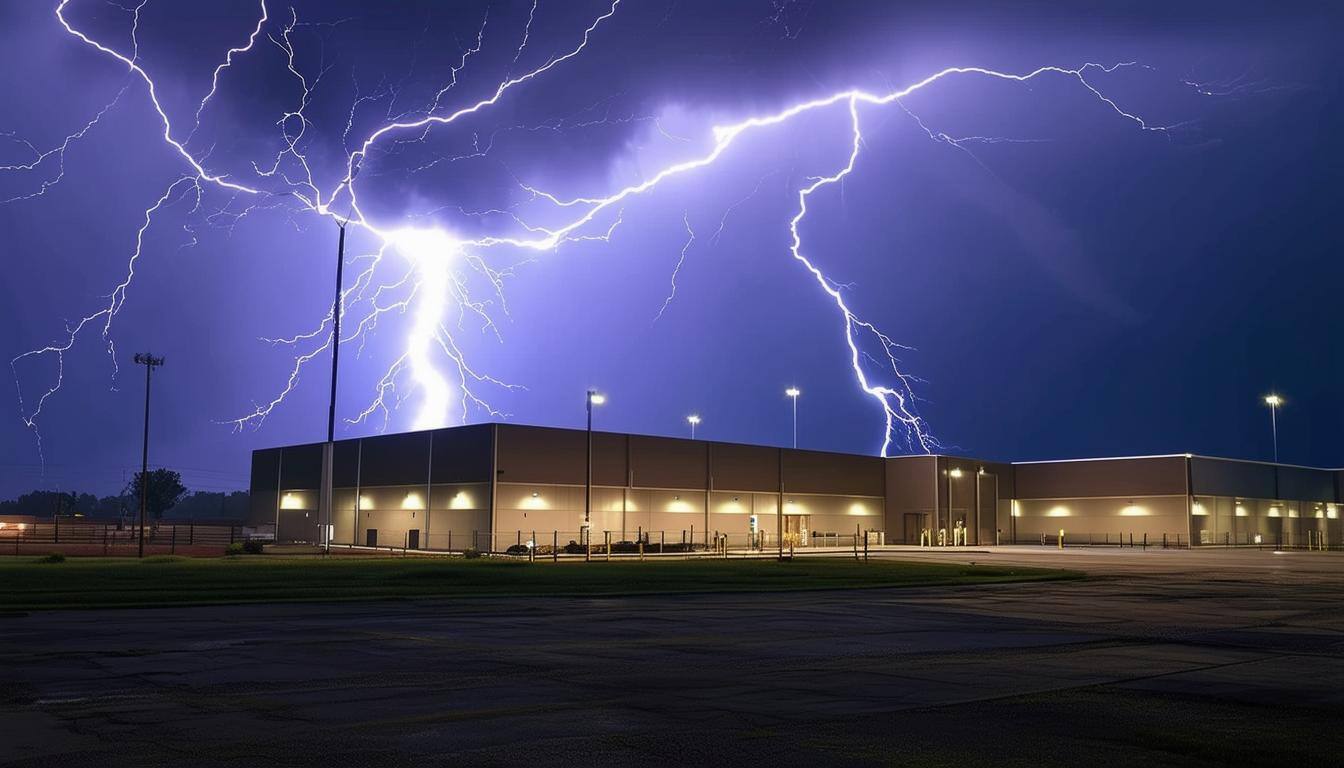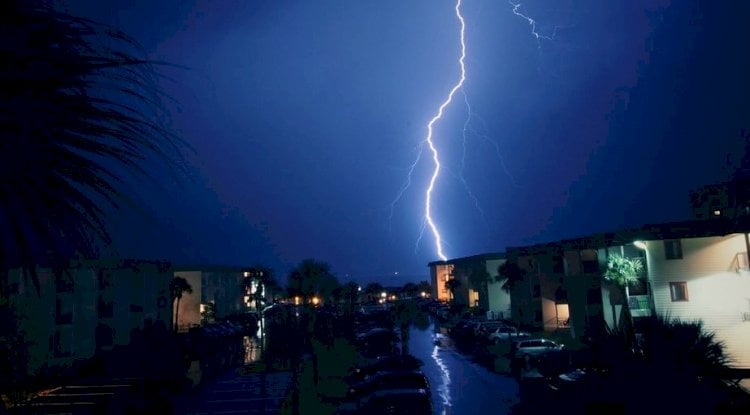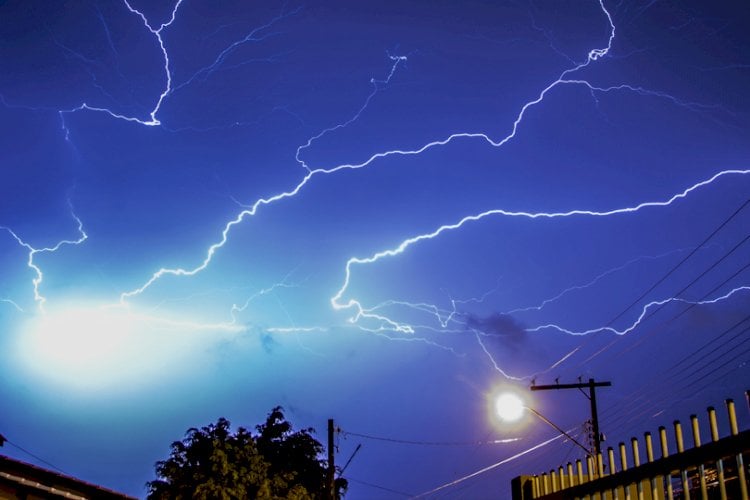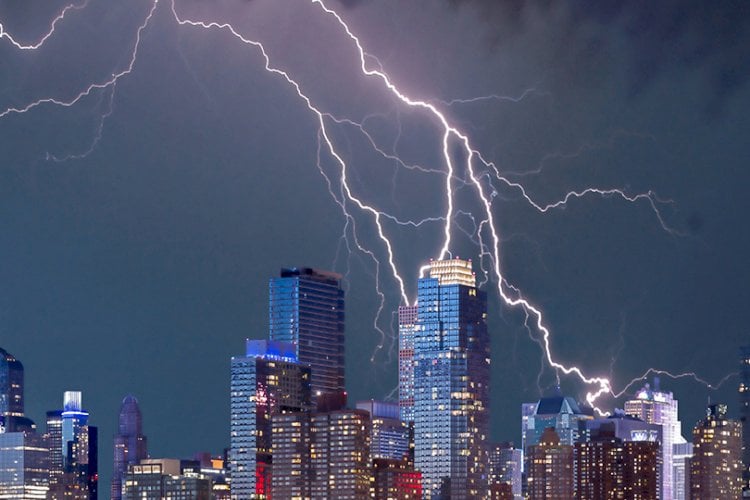A White Paper by E&S Grounding Solutions, Inc.
E&S Grounding Solutions, Inc. 28202 Cabot Road, Suite 300 Laguna Niguel, CA 92677 United States
Website: www.esgrounding.com Email: info@esgrounding.com Published: September 2025
Executive Summary
This white paper provides a comprehensive analysis of lightning protection systems, examining the scientific principles, regulatory standards, and safety implications of various technologies. The central thesis of this paper is that the installation of a lightning protection system does not increase or decrease the probability of a lightning strike to a structure. Instead, the primary purpose of a properly designed and installed lightning protection system is to provide a safe, low-impedance path for the immense energy of a lightning strike to follow to the earth, thereby preventing damage to the structure and its contents. A secondary purpose of an LPS is to provide electromagnetic interference (EMI) protection, as it functions as an effective Faraday cage. This paper will demonstrate that traditional Franklin-style lightning protection systems, designed and installed in accordance with established standards such as NFPA 780, provide the most effective and scientifically sound method of lightning protection. Conversely, this paper will present evidence that non-conventional systems, including Early Streamer Emission (ESE) systems, Charge Transfer Systems (CTS) or Dissipation Array Systems (DAS), and active voltage shield systems, are not supported by scientific evidence, have been repeatedly rejected by standards organizations, and in some cases, have been proven to be dangerous. The paper will conclude with recommendations for the implementation of effective lightning protection strategies based on proven science and established standards.
1. Introduction
Lightning is one of nature's most powerful and destructive forces. A single lightning strike can carry millions of volts of electricity and temperatures hotter than the surface of the sun. The potential for damage to structures, sensitive electronics, and the risk of injury or death to human beings is significant. For centuries, mankind has sought to understand and control the destructive power of lightning. From Benjamin Franklin's pioneering experiments with kites and keys to the development of modern, sophisticated lightning protection systems, the goal has remained the same: to safeguard people and property from the hazards of lightning.
This white paper will delve into the science and technology of lightning protection, providing a critical examination of the various systems available on the market today. It will explore the fundamental principles of lightning formation and attachment, and how these principles inform the design of effective protection systems. The paper will also provide a detailed analysis of the four primary ways that lightning can cause damage: direct strikes, strikes to power and data lines, electromagnetic pulse (EMP), and ground reference potential changes. Understanding these damage mechanisms is crucial to designing a comprehensive lightning protection strategy.
A central focus of this paper will be a critical review of both traditional and non- conventional lightning protection systems. Traditional Franklin-style systems, which are based on the principles of the Faraday cage, will be examined in detail, highlighting their proven effectiveness and acceptance by major standards organizations such as the National Fire Protection Association (NFPA) and the International Electrotechnical Commission (IEC). In contrast, this paper will present a wealth of evidence, including scientific studies, court rulings, and statements from leading scientific bodies, that demonstrates the ineffectiveness and potential dangers of non-conventional systems such as Early Streamer Emission (ESE) air terminals, Charge Transfer Systems (CTS) or Dissipation Array Systems (DAS), and active voltage shield systems. This paper will show that the claims made by the manufacturers of these non-conventional systems are not supported by credible scientific evidence and that these systems have been repeatedly rejected by the scientific and engineering communities.
Ultimately, this white paper aims to provide a clear, evidence-based guide for engineers, architects, facility managers, and anyone responsible for the safety of people and property from the dangers of lightning. By understanding the science,
standards, and safety considerations of lightning protection, it is possible to make informed decisions that will ensure the implementation of effective and reliable lightning protection systems.
2. The Science of Lightning
To understand how to protect against lightning, it is first necessary to understand the basic physics of how lightning is formed and how it strikes the earth. Lightning is a massive electrostatic discharge that occurs between electrically charged regions within clouds, or between a cloud and the Earth's surface. The formation of lightning is a complex process involving the separation of positive and negative charges within a thundercloud. The top of a thundercloud is typically positively charged, while the middle and lower parts of the cloud are negatively charged. This charge separation creates an enormous electric field, both within the cloud and between the cloud and the ground.
When the electric field becomes strong enough to overcome the insulating properties of air, a stepped leader is initiated. The stepped leader is a channel of ionized air that propagates downward from the cloud in a series of steps, each about 50 meters in length. As the stepped leader approaches the ground, the electric field at the ground level increases dramatically. This intense electric field causes upward-propagating streamers to be launched from grounded objects on the surface, such as trees, buildings, and lightning rods. When one of these upward streamers connects with the downward-propagating stepped leader, a complete, ionized channel is formed between the cloud and the ground. This is the point of attachment, and it is at this moment that the return stroke occurs.
The return stroke is the intensely luminous and powerful discharge that we see as lightning. It propagates upward from the ground to the cloud, following the path created by the stepped leader. The return stroke carries a massive amount of electrical current, typically in the range of 30,000 to 120,000 amperes, and can heat the air in the channel to temperatures of up to 50,000 degrees Fahrenheit, which is five times hotter than the surface of the sun. This rapid heating of the air is what causes the shock wave that we hear as thunder.
It is important to note that the attachment process is a probabilistic phenomenon. The stepped leader does not "choose" which object to strike. Instead, the object that is struck is the one that launches the upward streamer that successfully connects with
the stepped leader. The ability of an object to launch an upward streamer is influenced by its height, its shape, and its electrical conductivity. Taller, sharper, and more conductive objects are more likely to launch upward streamers and are therefore more likely to be struck by lightning. However, it is crucial to understand that the presence of a lightning protection system does not attract lightning or increase the likelihood of a strike. A lightning protection system simply provides a preferred, low-impedance path for the lightning to follow to the ground, once the attachment process has already occurred.
2.1. The Four Types of Lightning Damage
Lightning can cause damage in four primary ways. Understanding these different damage mechanisms is essential for designing a comprehensive lightning protection system. The four types of lightning damage, in order of likelihood, are:
- Electromagnetic Pulse (EMP) Damage
This is the most common type of lightning damage and can affect facilities miles away from the actual strike. A lightning strike creates a powerful electromagnetic pulse (EMP) that can induce large transient voltages and currents in nearby power lines, data lines, and other conductive systems. These power surges can damage or destroy sensitive electronic equipment, such as computers, communication systems, and industrial control systems. The most effective way to protect against EMP damage is to create a Faraday cage around the structure.
- Ground Reference Potential Change Damage
When lightning strikes the ground, the electrical potential of the ground in that area can rise to a very high level. If different parts of a structure or system are at different ground potentials, a large current can flow between them, causing damage to electrical and electronic systems. This is why a well-designed grounding and bonding system is a critical component of any lightning protection system.
- Strikes to Power and Data Lines Causing Surges
Lightning strikes to power and data lines are significantly more likely than direct strikes to a facility. There are thousands of kilometers of power and data lines leading to any given site, creating an extensive network of potential lightning targets. When lightning strikes these lines, it can send dangerous surges directly into the facility
through the electrical and data infrastructure. These surges can cause extensive damage to electrical systems, electronic equipment, and sensitive data processing equipment. The vast network of power and data lines makes this type of damage more probable than direct strikes to the structure itself, as the lines present a much larger target area for lightning attachment.
- Physical or Direct Strike Damage
This is the least common type of lightning damage, but it is also the most dramatic. A direct lightning strike can cause significant physical damage to a structure, including fires, explosions, and the destruction of building materials. The primary purpose of a traditional lightning protection system is to provide a safe path for the lightning current to follow to the ground, thereby preventing this type of damage.
It is important to recognize that a comprehensive lightning protection strategy must address all four of these damage mechanisms. A system that only protects against direct strikes is incomplete and will not provide adequate protection for a modern facility with its sensitive electronic systems. Given that strikes to power and data lines are more likely than direct strikes due to the extensive network of conductors leading to any facility, surge protection becomes a critical component of any lightning protection strategy.
3.
Traditional Lightning Protection Systems: The Franklin Rod and the Faraday Cage
The traditional lightning protection system, often referred to as a Franklin-style system, is based on the pioneering work of Benjamin Franklin in the 18th century. The fundamental principle of a traditional lightning protection system is to provide a low- impedance path for the lightning current to follow to the ground, thereby protecting the structure from damage. A traditional lightning protection system consists of three main components:
- Air Terminals: These are the pointed metal rods, often called lightning rods, that are mounted on the highest points of a structure. The purpose of the air terminals is to intercept the lightning strike.
- Down Conductors: These are heavy-duty electrical conductors, typically made of copper or aluminum, that connect the air terminals to the grounding The
purpose of the down conductors is to provide a safe and direct path for the lightning current to travel from the air terminals to the ground.
- Grounding System: This is a network of buried conductors, often in the form of a ground ring encircling the structure, that is designed to dissipate the lightning current safely into the A low-impedance grounding system is essential for the effective operation of a lightning protection system.
When these three components are properly installed and bonded together, they create a Faraday cage around the structure. A Faraday cage is a continuous, conductive enclosure that protects its contents from external electromagnetic fields. In the context of lightning protection, the Faraday cage created by a traditional lightning protection system serves two critical functions:
- Direct Strike Protection: The Faraday cage intercepts the lightning strike and provides a safe path for the current to flow to the ground, preventing it from passing through the structure and causing physical
- Electromagnetic Pulse (EMP) Protection: The Faraday cage also shields the interior of the structure from the powerful electromagnetic pulse (EMP) that is generated by a lightning This is the most important function of a lightning protection system, as EMP is the most common cause of lightning-related damage.
The effectiveness of traditional lightning protection systems is well-established and is supported by more than two centuries of successful field experience. The design and installation of traditional lightning protection systems are governed by internationally recognized standards, such as NFPA 780, Standard for the Installation of Lightning Protection Systems, and IEC 62305, Protection against lightning. These standards are developed by committees of experts in the field of lightning protection and are based on sound scientific principles and extensive testing. When a traditional lightning protection system is designed and installed in accordance with these standards, it provides a high level of protection against all four types of lightning damage.
4.
Non-Conventional Lightning Protection Systems: A Critical Review
In recent decades, a number of non-conventional lightning protection systems have been introduced to the market, with manufacturers claiming that these systems offer superior performance to traditional Franklin-style systems. These non-conventional systems can be broadly categorized into three types: Early Streamer Emission (ESE) systems, Charge Transfer Systems (CTS) or Dissipation Array Systems (DAS), and active voltage shield systems.
Interestingly, these non-conventional systems represent two fundamentally opposite approaches to lightning protection. ESE systems are designed to attract lightning strikes by allegedly extending the reach of upward streamers, thereby claiming to provide enhanced protection over a larger area. In contrast, CTS/DAS systems and active voltage shield systems claim to prevent or reduce lightning strikes altogether by either dissipating atmospheric charge or repelling lightning through opposite polarity voltages. The failure of both approaches provides compelling evidence that mankind cannot reliably control the probability of lightning strikes.
4.1. Early Streamer Emission (ESE) Systems
ESE systems represent mankind's most sophisticated attempt to deliberately attract lightning strikes to a preferred location. These systems are based on the theory that by launching an upward streamer earlier than a conventional air terminal, they can create a larger zone of protection. The original concept was that by adding electrons to the system, the streamer could be extended further than normal, effectively increasing the length and height of the lightning protection system's aerial. ESE manufacturers claim that their devices can protect a much larger area than a traditional lightning rod, and they often market their products as a more cost-effective alternative to a full, standards-compliant lightning protection system.
However, this ambitious attempt to control and attract lightning has failed comprehensively. The original ESE system concept failed primarily because of environmental factors such as wind and rain, which interfered with the theoretical enhancement mechanisms. The claims made by ESE manufacturers are not supported by credible scientific evidence, and decades of field experience have demonstrated their ineffectiveness.
In a comprehensive review of ESE technology, the National Fire Protection Research Foundation concluded that "the claims for enhanced performance of ESE air terminals are not supported by theory, by laboratory testing, or by field experience." [1] Similarly, a critical review of non-conventional lightning protection systems by Dr. Martin A. Uman and Dr. Vladimir A. Rakov, two of the world's leading experts on lightning, concluded that "neither data nor theory supports claims that... 'early streamer emission' techniques are superior to conventional lightning protection systems." [2]
Furthermore, ESE systems have been repeatedly rejected by all major standards organizations, including the National Fire Protection Association (NFPA), the International Electrotechnical Commission (IEC), and Underwriters Laboratories (UL). In a landmark legal case, a U.S. Federal Court ruled that the advertising claims made by an ESE manufacturer were "literally false." [3]
The scientific and engineering communities have overwhelmingly rejected the claims of ESE manufacturers. The International Conference on Lightning Protection (ICLP), the world's most prestigious scientific body dedicated to the study of lightning, has issued a statement strongly opposing the use of ESE systems, citing the lack of scientific basis and the potential for these systems to endanger human lives. [4]
4.2. Charge Transfer Systems (CTS) and Dissipation Array Systems (DAS)
In direct contrast to ESE systems, CTS and DAS systems represent mankind's attempts to prevent lightning strikes altogether. These systems are based on the theory that they can reduce or eliminate lightning strikes by dissipating the electrical charge in the atmosphere around a protected structure. These systems typically consist of a large array of sharp points that are designed to create a corona discharge, which is a continuous, low-level discharge of electrical energy. The manufacturers of these systems claim that this corona discharge can neutralize the charge in a thundercloud, thereby preventing a lightning strike from occurring.
However, like the attempts to attract lightning through ESE systems, these efforts to prevent lightning strikes have also failed. The claims made by CTS and DAS manufacturers are not supported by credible scientific evidence. The amount of electrical charge in a thundercloud is enormous, and the idea that a small, ground- based device can neutralize this charge is not scientifically plausible. Furthermore, even if these systems could slow the formation of upward streamers as claimed, this
could actually be counterproductive, as it would allow the lightning strike to get closer to the structure before a streamer forms, potentially increasing rather than decreasing the risk of damage. In their critical review of non-conventional lightning protection systems, Drs. Uman and Rakov concluded that "there is no basis in physics for the claims that... 'lightning elimination' devices are effective." [2]
Like ESE systems, CTS and DAS systems have been repeatedly rejected by all major standards organizations. The NFPA has on four separate occasions (1989, 1991, 2000, and 2005) denied requests to begin standards development for these systems, citing the lack of a sound scientific basis for their claims.
4.3. Active Voltage Shield Systems
Active voltage shield systems are a relatively new type of non-conventional lightning protection system. These systems are based on the theory that by applying a small voltage of the opposite polarity to a protected structure, they can repel a lightning strike. However, this theory is fundamentally flawed. A lightning strike involves millions of volts of electricity, and the idea that a few volts of the opposite polarity can repel it is not scientifically plausible. There is no credible scientific evidence to support the claims of active voltage shield manufacturers, and these systems have not been accepted by any major standards organizations. Tragically, there have been documented cases of deaths and injuries associated with the failure of these systems.
5. Conclusion
The science of lightning protection is well-established, and the principles of the Faraday cage have been proven effective for more than two centuries. Traditional lightning protection systems, designed and installed in accordance with internationally recognized standards such as NFPA 780, provide a high level of protection against all four types of lightning damage. These systems do not attract lightning or increase the likelihood of a strike, but rather provide a safe and effective path for the lightning current to follow to the ground.
The failure of non-conventional lightning protection systems provides compelling evidence for a fundamental truth about lightning protection: mankind cannot reliably control the probability of lightning strikes. Despite decades of research and development, mankind's most sophisticated attempts to attract lightning strikes (ESE systems) have failed, and similarly, attempts to prevent or reduce lightning strikes
(CTS/DAS and active voltage shield systems) have also failed. If humanity's best efforts to deliberately increase the likelihood of lightning strikes have been unsuccessful, this provides strong evidence that traditional lightning protection systems, which make no such claims, do not increase or decrease the probability of lightning strikes to a structure.
In contrast, non-conventional lightning protection systems, such as Early Streamer Emission (ESE) systems, Charge Transfer Systems (CTS) or Dissipation Array Systems (DAS), and active voltage shield systems, are not supported by credible scientific evidence. These systems have been repeatedly rejected by all major standards organizations, and in some cases, have been proven to be dangerous. The claims made by the manufacturers of these non-conventional systems are not based on sound scientific principles, and there is no evidence that these systems provide any additional protection beyond that of a traditional Franklin-style system.
When it comes to protecting people and property from the destructive power of lightning, there is no substitute for a properly designed and installed lightning protection system that is based on proven science and established standards. The use of non-conventional systems that lack a sound scientific basis is not only a waste of money, but it can also create a false sense of security that can lead to tragic consequences. It is the recommendation of this white paper that only traditional, standards-compliant lightning protection systems be used to protect structures from the hazards of lightning.
6. References
- National Fire Protection Research Foundation, "A Critical Review of Early Streamer Emission Air Terminals," Quincy, MA, 1995.
- A. Uman and V. A. Rakov, "A Critical Review of Nonconventional Approaches to Lightning Protection," Bulletin of the American Meteorological Society, vol. 83, no. 12,
- 1809-1820, 2002. [Online]. Available: http://www.lightning.ece.ufl.edu/PDF/umanrakov.pdf
- Heary Lightning Protection Co. v. National Fire Protection Association, No. CIV 99-185-TUC-WDB (D. Ariz. Mar. 28, 2005).
- International Conference on Lightning Protection (ICLP), "Statement on ESE (Early Streamer Emission) Lightning Protection Systems," [Online]. Available:
https://www.iclp-centre.org/pdf/ICLP_statement_on_ESE_2012.pdf




